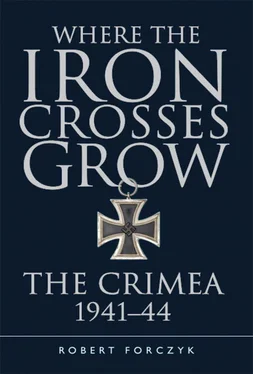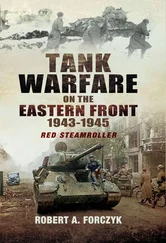Meanwhile, Gruppe Konrad had fallen back precipitously from the Ishun position, but a good part of the artillery was saved thanks to the rearguard fought by two batteries of the Sturmgeschütz-Brigade 279. Elements of the Soviet 19th Tank Corps actually got ahead of the retreating Germans – just as Brigade Ziegler had done to Petrov’s retreating army in 1941. German columns were forced to form all-around defensive hedgehogs at nightfall, lest they be surprised and attacked by marauding Soviet mechanized units. One Romanian battalion that did not form a hedgehog was caught by Soviet tanks and opted to surrender. In another ambush, the Soviets managed to knock out two StuG III assault guns, but the rest of Sturmgeschütz Brigade 279 fought its way out of the enemy ambush. [8] Franz Kurowski, Sturmgeschütz vor! Assault Guns to the Front! (Winnipeg: J. J. Fedorowicz Publishing, 1999), p. 139.
By the time that Gruppe Konrad reached the Gneisenau Line on April 12/13, it found its retreat route blocked by Soviet forces and was obliged to fight its way through the Kessel forming around them. Gruppe Konrad succeeded in fighting through the Soviet pincers, but only by retreating as fast as possible. The Romanian 19th Infantry Division was hard pressed by the Soviet tankers, and some of its battalions were destroyed.
Contrary to what Hitler thought, Sevastopol was not prepared for another siege. A total of seven Romanian mountain-infantry battalions were manning a thin outer perimeter, which was much weaker than the Soviet positions of 1942. German naval engineers had repaired a few flak positions and built some additional bunkers, but very little had actually been done to prepare the naval base for a ground attack. The man on the spot was Oberst Paul Betz, an engineer officer, who had been designated as commander of Festung Sevastopol just two weeks prior. Betz had spent six months with the Afrikakorps in North Africa, then spent much of 1942–43 as a senior pioneer leader for AOK 17 in the Caucasus. Upon the activation of Adler , he formed a Kampfgruppe from Feldausbildungs Regiment 615 (FAR 615), six flak batteries from Pickert’s 9. Flak-Division, and the Luftwaffe’s armored flak train “Michael.” Betz moved his Kampfgruppe to block the main road to Sevastopol, just south of Bakhchisaray. When the lead elements of Gruppe Konrad arrived late on April 13, Betz was given six of the last operational StuG III assault guns to reinforce his position. At dawn on April 14 the vanguard of the 19th Tank Corps arrived at Bakhchisaray, but Kampfgruppe Betz was able to delay them for 12 critical hours, while Gruppe Konrad withdrew into Sevastopol. Then, Betz broke contact and fell back under the cover of a barrage from Gruppe Konrad’s artillery.
While the Germans retreated, Schwab deployed all three of his mountain divisions on Sevastopol’s perimeter, with the 1st and 2nd Mountain Division barring the direct routes in from the north. On the morning of April 15, the 19th Tank Corps began probing attacks against the Romanian defenses, but the mountain-infantry battalions continued to display combat effectiveness and they knocked out 23 Soviet tanks. It took Konrad 24 hours or more to get the disorganized 50. and 336. Infanterie-Divisionen into the perimeter lines, which meant that it was the Romanians who defeated the initial Soviet attacks on their own. Tolbukhin continued probing the Romanians for the next week, but not in great strength. Tolbukhin apparently believed that the Axis defenses of Sevastopol were much stronger than they really were and that a deliberate attack was necessary, so he decided to wait for his artillery to arrive before mounting a serious offensive. In fact, Jaenecke had fewer than 20,000 organized combat troops left after the retreat. In just nine days, AOK 17 had suffered 29,873 casualties, as well as losing a great deal of its equipment. Allmendinger, who had begun to display odd behavior during the retreat, decided to go on leave for a week, and left V Armeekorps under temporary command of a Romanian mountain-infantry officer – a bizarre action for a German general. The two most effective German units, the assault-gun brigades, were reduced to only a handful of operational vehicles. Luftwaffe air support dwindled after the loss of 70 aircraft, and fewer than 50 aircraft remained operational in the Crimea, including 16 Bf-109s and 21 ground-attack aircraft. Simply put, AOK 17 was no longer capable of effective resistance.
____________
The first phase of the Axis evacuation from the Crimea began on April 12, but was ostensibly restricted to non-combat personnel. The Germans initially committed nine merchant ships and all their remaining Kriesgmarine assets in the Black Sea to the operation, while the Romanians committed a good part of their merchant marine as well. For the first time in the war, the Romanian Navy also decided to risk its best warships on the Constanta–Sevastopol run, the Italian-built destroyers Regina Maria and Regele Ferdinand . Despite frequent Soviet air and submarine attacks, the evacuation was able to operate for nearly a week without loss. Most of the convoys consisted of two or three merchant ships with robust escort and sometimes fighter cover from Bf-110s based in Romania. By the time that Gruppe Konrad and V Armeekorps reached the perimeter of Sevastopol, the Kriesgmarine and Romanian Navy – as well Morzik’s air transports – had already transferred more than 20,000 people from the Crimea to Romania, and the operation was in full swing.
Yet it was not until April 18 that the Soviets achieved any success against the Axis convoys. The VVS-ChF committed two units equipped with US-made A-20G Havoc bombers to the interdiction mission – the 36th Mine-Torpedo Aviation Regiment (MTAP) and 13th Guards Bomber Regiment (GDBAP). A two-ship Romanian convoy that was returning to Constanta was spotted by the Soviet submarine L-6 about 90 miles southwest of Sevastopol around 1100hrs. The Soviet submarine fired a torpedo at the convoy but missed, and was apparently sunk by depth charges from the counterattacking escort UJ-104 . However, four A-20G Havoc bombers from the 36th MTAP found the convoy at 1237hrs and put two bombs into the freighter Alba Iulia (5,700 GRT). Ironically, the freighter was loaded mostly with Soviet POWs, and about 500 of them died in the attack. Although the vessel was abandoned, it was recovered the next day and towed back to Constanta by the destroyer Regele Ferdinand. Although Hitler had decreed that no combat troops would be evacuated from the Crimea, the Romanians ignored him and proceeded to evacuate considerable numbers of their own combat troops, including mountain infantry. On April 22 both A-20 bomber groups mounted separate attacks against another convoy, which crippled the small German tanker Ossag I (3,950 GRT), and scored a lucky hit – which did not explode – on the destroyer Regele Ferdinand. Although the escorting German R-Boats tried to shepherd the crippled Ossag I and its vital cargo of fuel into Sevastopol, they were forced to scuttle it 17 miles southwest of the port. Three Soviet A-20G bombers were lost in the attacks.
Soviet submarines made repeated attacks on the convoys but failed to achieve any hits. The two A-20G bomber-equipped regiments continued to attack daily convoys, inflicting light damage but suffering regular losses. Once Soviet forces reached the perimeter of Sevastopol, the VVS also committed Il-2 Sturmovik ground-attack aircraft to attack the convoys when they were close to the coast. On April 23, Il-2s sank an MFP that was overcrowded with 1,000 troops – but due to prompt rescue efforts by the escort two-thirds of the men were saved. On April 27 two large convoys left Sevastopol with a strong escort, but were attacked 11 miles southwest of Sevastopol by five Soviet MTBs. The Soviets managed to torpedo the escort UJ-104 , but two S-Boats from the 1. Schnellbootsflottille sank one of the Soviet boats and the rest retreated. The first phase of the Axis evacuation from the Crimea lasted from April 12 to 27, 1944, and succeeded in evacuating almost 72,000 personnel, including 28,394 German and 20,779 Romanian troops. Interestingly, fewer than a fifth of the military evacuees were wounded, indicating that many unauthorized personnel were leaving. A number of German combat troops from the assault-gun units and artillery battalions that had lost much of their equipment in the retreat were evacuated as well. The Axis also evacuated all the Slovak and Caucasian volunteer troops, as well as Hiwis , POWs, and civilians. The initial Axis evacuation from the Crimea was a staggering accomplishment, and was achieved with less than 2 percent losses.
Читать дальше












